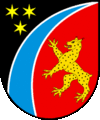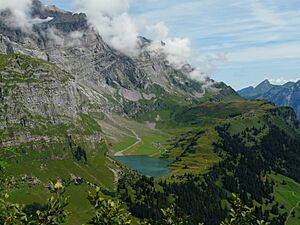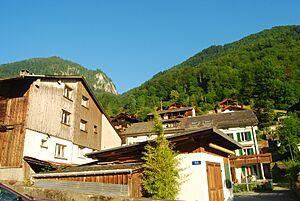Luchsingen facts for kids
Quick facts for kids
Luchsingen
|
||
|---|---|---|
|
Village (and former municipality)
|
||
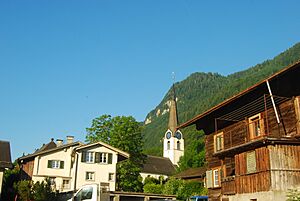 |
||
|
||
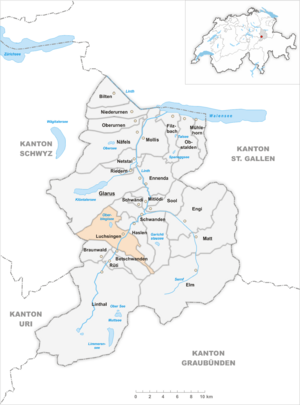
The former municipal area (2007)
|
||
| Country | Switzerland | |
| Canton | Glarus | |
| Municipality | Glarus Süd | |
| Area | ||
| • Total | 30.76 km2 (11.88 sq mi) | |
| Elevation | 572 m (1,877 ft) | |
| Population
(December 2020)
|
||
| • Total | 1,119 | |
| • Density | 36.378/km2 (94.22/sq mi) | |
Luchsingen is a lovely village in Switzerland. It used to be its own municipality (a local government area). Now, it's part of the larger municipality of Glarus Süd in the canton of Glarus.
Contents
History of Luchsingen
Luchsingen was first mentioned in old records way back in 1274. That's a long time ago!
In 2004, two other nearby places, Hätzingen and Diesbach, joined with Luchsingen. This made Luchsingen a bigger municipality. Then, on January 1, 2011, this larger Luchsingen became part of the even bigger municipality of Glarus Süd.
Geography of Luchsingen
Luchsingen is located in a valley next to the Linth river. The village itself sits on the west side of the river. It's about 572 meters (1,877 feet) above sea level.
To the north of Luchsingen is the village of Leuggelbach. Across the river to the south is Hätzingen. Besides the main village, Luchsingen also includes a small settlement called Adlenbach. There's also a vacation home area called Schlatt.
Above the village to the west, you'll find the Bächibach stream valley. There's also a pretty lake called Oberblegisee, which is about 1,422 meters (4,665 feet) high. This area is surrounded by impressive mountains like Eggstock (2,455 m or 8,054 ft), Bös Fulen (2,802 m or 9,193 ft), Rüchigrat (2,657 m or 8,717 ft), and Glärnisch (2,915 m or 9,564 ft).
In 2006, the area of Luchsingen was about 30.7 square kilometers (11.9 square miles). A good part of this land, about 26.9%, is used for farming. Forests cover 31.8% of the area. About 2% of the land has buildings or roads. The rest, 39.4%, is made up of non-productive areas like rivers, glaciers, or mountains.
Transport in Luchsingen
Luchsingen is on Hauptstrasse 17, which is a main road that goes through the canton of Glarus. This road then climbs up the Klausen Pass into the canton of Uri.
There's also a railway line, the Weesen-Linthal railway line, that runs next to the main road and the Linth river. The Klausen Pass is usually only open from June to September. For the rest of the year, the road and railway are the only ways to get to the village.
The village has its own train station, Luchsingen-Hätzingen railway station. You can catch the hourly Zürich S-Bahn train service S25 here. This train connects Luchsingen to Linthal and Zürich.
You can also find cable cars in Luchsingen. These cable cars connect the village to Brunnenberg and Schlatt, which are higher up on the slopes.
People of Luchsingen
As of 2014, Luchsingen had a population of 1,614 people within its former municipal area. In 2007, about 16.7% of the people living there were from other countries. Over the last 10 years, the population has decreased by about 9.5%.
Most people in Luchsingen speak German (84.5%). Italian is the second most common language (4.4%), and Turkish is third (2.1%).
Swiss people are generally well educated. In Luchsingen, about 67.5% of adults aged 25-64 have finished high school or gone on to higher education, like a university.
Luchsingen has a low unemployment rate of 1.9%. In 2005, 47 people worked in farming (the primary economic sector). There were 21 businesses in this area. 23 people worked in manufacturing (the secondary sector), with 11 businesses. Finally, 135 people worked in services (the tertiary sector), with 29 businesses.
Here's how the population of Luchsingen has changed over the years:
| year | population |
|---|---|
| 1850 | 652 |
| 1900 | 789 |
| 1950 | 768 |
| 2000 | 592 |
Notable People from Luchsingen
The family name Luchsinger (sometimes spelled Lucksinger) is thought to have come from this very village!
Other famous people connected to Luchsingen include:
- Jakob Klaesi (1883–1980) was a psychiatrist. He was known for his work in sleep therapy, which helps people with sleep problems.
See also
 In Spanish: Luchsingen para niños
In Spanish: Luchsingen para niños


